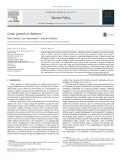
In a clean energy economy, green businesses play a central role by utilizing renewable energy technologies and employing green labor forces to provide clean energy services and goods. This paper aims at analyzing factors driving the growth and survival of green businesses in the U.S. states, with hypotheses proposed on the impacts from clean energy policies and tax incentives, labor market conditions, and economic and political environments. A fixed effect regression analysis is applied with a panel data set of 48 continental states from 1998 to 2007 in the United States. The statistical analysis with a longitudinal data set reveals that the adoption of renewable energy policies, the permission of renewable energy credits imports, the stringency of minimum wage legislations, and presence of clean energy business associations are the major driving forces of the green business development in the U.S. states.

Hopes for a grand deal were mercilessly shattered at Copenhagen in December 2009 and in other recent UNFCCC meetings, with the result that “green growth” is promoted as an alternative path. Indeed, green growth is clearly the goal, but it is no magic bullet. The world economy will require clear and rather tough policy instruments for growth to be green—and it is naïve to think otherwise. Growth, green or not, will boost demand for energy and coal is normally the cheapest source. The magnitude of the challenge is greater if we also consider the problems related to nuclear (fission) energy and, in some instances, to bioenergy (such as its competition for land that may be essential for the poor). This paper discusses some necessary ingredients for a long-term global climate strategy. As we wait for the final (and maybe elusive) worldwide treaty, we must find a policy that makes sense and is not only compatible with, but facilitates the development of such a treaty.
One main theme in the Rio+20 Conference was how to facilitate the growth of green industries. How can politicians more specifically promote renewable green industries such as wind turbines or solar energy? How can we get prices right in the market? Prices can be adjusted by the use of economic instruments such as taxes and subsidies. In this way, renewable energy sources and green industries become more competitive, thus enhancing the transition from brown to green economy. Not only can these economic incentives accelerate the so-called switch point in time from fossil fuel–based energy sources to those not based on fossil fuel, they also encourage innovation. An illustrative example of this logic in practice is the case of Danish wind energy production.

